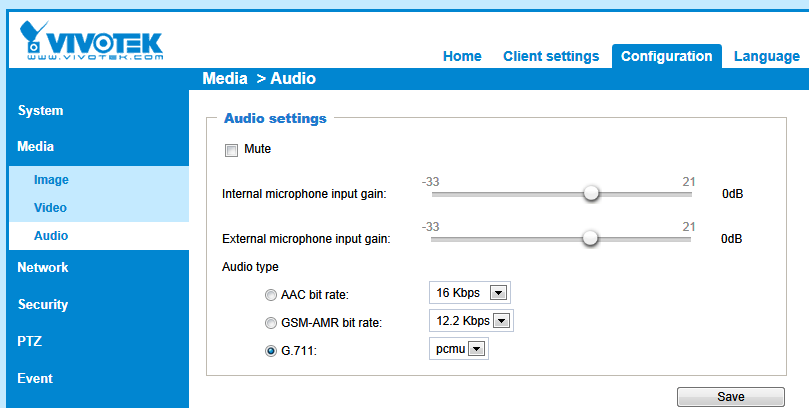List of Supported Camera Manufacturers and Types
For Arecont Vision, only H.264 cameras can be operated over RTSP (designation ends in 5, such as AV3105).
All cameras that only provide JPEG support (designation ends in 0, such as AV1300) do not provide RTSP support. None of the Arecont Vision cameras supports Audio! Only TCP and UDP are allowed as transport protocols. No support of multicast for all Arecont Vision cameras.
For Arecont Vision, the setting of the steam is controlled solely via the RTSP request. To specify the request, open the camera in the browser and set up the camera as desired using the following menu:
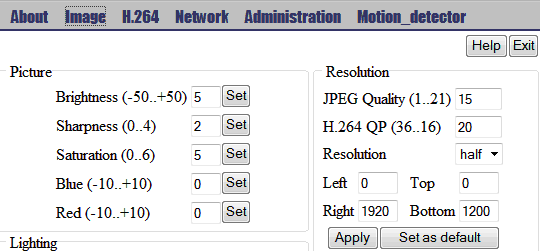
Then go to H.264 and have an RTSP request generated using Update link. Then enter the Update link in G-Set.
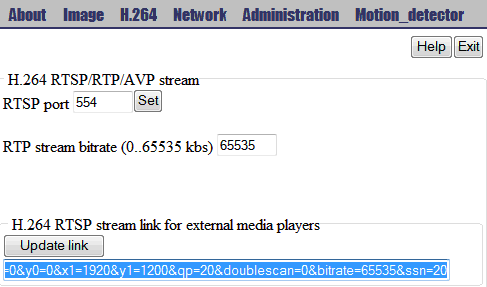
Example rtsp://10.1.92.162:554/h264.sdp?res=half&x0=0&y0=0&x1=1920&y1=1200&qp=20&doublescan=0&bitrate=65535&ssn=20
Arecont Vision cameras are dual-stream capable. Generate two different RTSP requests. Note, however, that the possible number of images can drop significantly when more streams are opened.
Login Data
By default, there is no password assigned for Arecont Vision cameras for the users admin and viewer. Therefore, with default settings you do not need to enter a password for either user. However, if passwords have been assigned, it is important to enter the admin user with the corresponding password in G-Set. Otherwise, you may see images but not be able to control the Image Settings.
The plugin works in conjunction with Axis cameras firmware version 5.xx and up. You can find a list of cameras with these firmware versions here: http://www.axis.com/techsup/firmware.php
To change the camera to the desired configuration, make the modifications here:
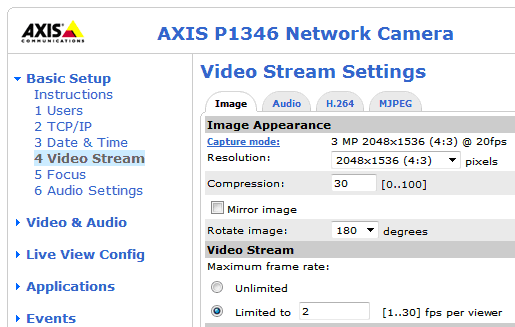
The RTSP request for Axis cameras for FW 5.xx or higher is:
|
RTSP Request |
Description |
|---|---|
|
rtsp://ip/axis-media/media.amp?videocodec=h264 |
This will provide you with an H.264 video stream. |
|
rtsp://ip/axis-media/media.amp?videocodec=jpeg |
This will provide you with an MJPEG video stream. |
Axis cameras are perfectly suited for dual streaming. But this only makes sense if you add additional parameters to the RTSP request.
Example For example, you could record at maximum resolution and low FPS while live streaming with high FPS and low-resolution:rtsp://192.168.0.50/axis-media/media.amp?videocodec=jpeg&resolution=2048x1536&fps=3rtsp://192.168.0.50/axis-media/media.amp?videocodec=jpeg&resolution=640x480&fps=25
In the section Axis Plugin, the activation of the audio support is explained.
For the use of the audio support, &audio=1 must be added to the RTSP-URL!
The transport protocols TCP, UDP and multicast are supported. All three use the same URL. For multicast, the check box Use Camera Settings must be activated and the multicast-specific settings must be specified via the Web interface of the camera. Specification of the multicast parameters via the Universal RTSP plugin is not allowed by Axis.
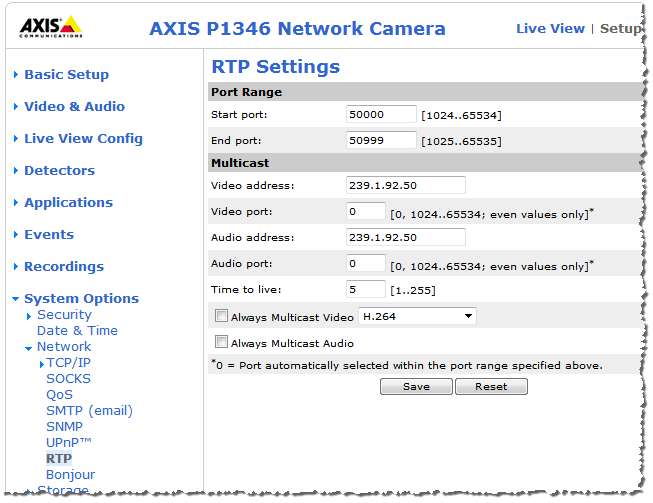
Login Data
There is no default password for Axis products. During first use of a camera, when the user opens the camera IP in the web browser, a password must be entered for the user root. The password selected there must also be entered in G-Core.
Cameras from Basler that support H.264 can be streamed via RTSP. JPEG cannot be streamed via RTSP and is therefore not supported.
BIP cameras, first-generation Basler cameras, can only provide one stream in H.264. Therefore, they cannot be used for dual streaming. All BIP2 camera models, second-generation Basler cameras, are dual-stream capable and can provide two and more H.264 streams.
The stream settings are made on the page shown. It is also important to pay attention to the settings under Global. Audio is supported as well, if camera is able. For detailed information, refer to the camera instructions.
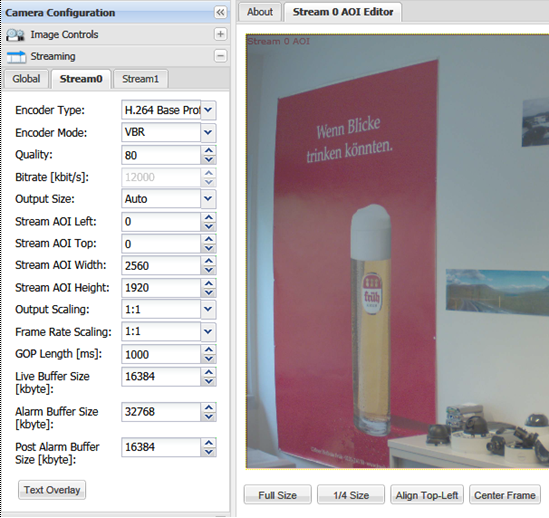
The transport protocols TCP, UDP and multicast are supported.
Note that only the stream=0 can be transmitted per multicast and that for the query another URL is to be entered. See example.
For multicast, the Use Camera Settings check box must be activated and the multicast-specific settings must be specified via the Web interface of the camera. Specification of the multicast parameters via the Universal RTSP plugin is not allowed by Basler.

The RTSP-URL is composed as follows, where X is replaced by the stream numbers 0 to 3: rtsp://ip/h264?stream=<X>&mode=live
Example
rtsp://ip/h264?stream=0&mode=live
rtsp://ip/h264?stream=1&mode=live
rtsp://ip/h264?multicast (Only for Multicast)
Login Data
By default, no login data is required for Basler cameras.
Bosch cameras can be operated in dual stream mode. In addition, audio and all three transmission protocols (TCP, UDP and multicast) are supported.
The transmission mode TCP is possible, but not recommended, as problems continually arise from the camera side. UDP is the preferred type of transmission. UDP is the preferred type of transmission.
The following URLs must be selected for this method. Keep in mind that for multicast, modified URLs must be used.
Example
rtsp://ip/?inst=1&enableaudio=1 (Bosch Stream 1)
rtsp://ip/?inst=2&enableaudio=1 (Bosch Stream 2)
rtsp://ip/?h26x=4&line=1&inst=1&multicast=1 (Bosch Multicast Stream 1)
rtsp://ip/?h26x=4&line=1&inst=2&multicast=1 (Bosch Multicast Stream 2)
The basic settings of the streams are specified here:
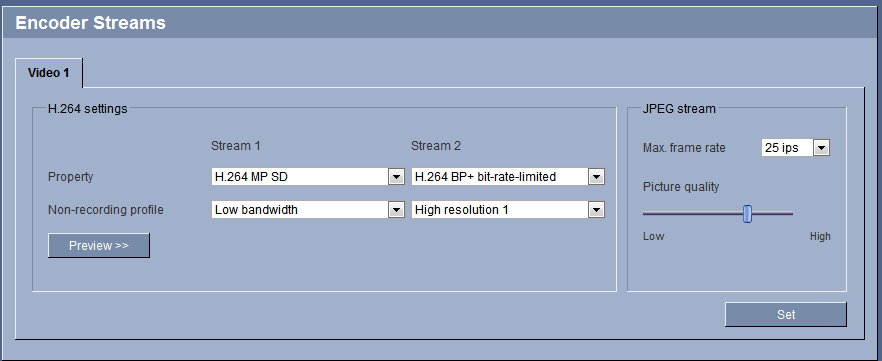
The settings for frame rate, quality and bit rate are controlled using the selected profiles:
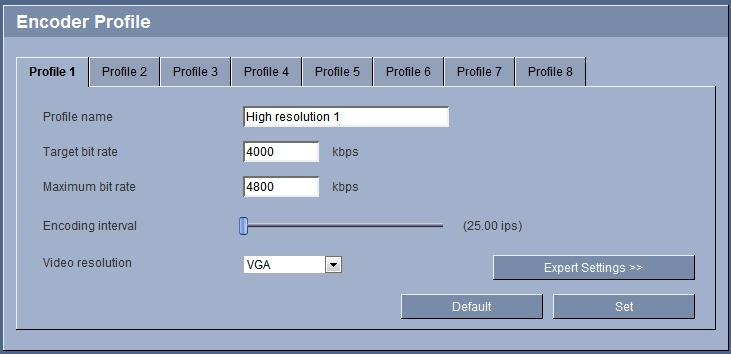
When multicast is to be used as a transport protocol, the corresponding stream must first be activated under settings Advanced Mode > Network > Multicast. Do not forget to enter a valid multicast address!
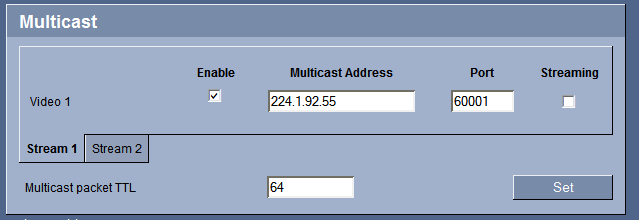
Login Data
By default, no login data is required for Bosch cameras.
The stream settings are made at the location shown.
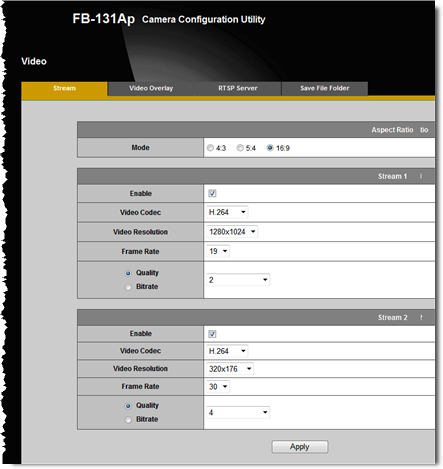
The cameras are dual-stream capable. Only the transport protocols TCP and UDP are supported. No multicast support!
The following RTSP request must be used.
-
For stream 1:
rtsp://ip/channel1 -
For stream 2:
rtsp://ip/channel2
BrickCom can transmit H.264 as well as JPEG over RTSP.
Login Data
The default user and password for BrickCom is admin.
Activate the audio streaming by setting a check mark in the Audio menu. You must select G.711 as Audio Codec.

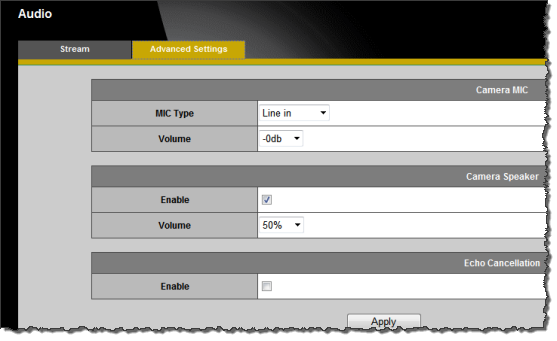
For CNB, there are different types of cameras with different RTSP-URLs. Up till now, only the following types have been tested and approved. Both types are dual-stream capable. MJPEG and H.264 are supported. Not MPEG4!
G-Model: IGx10xx, IxP40xx, IxP4000xx
-
To open the main stream:
rtsp://ip -
To open the substream:
rtsp://ip:665
A2-Model: IDC4050x, IGC2085F
-
To open the main stream:
rtsp://ip/main -
To open the substream:
rtsp://ip/sub
The configuration of the camera is performed via the website (see below). To activate the substream, the check mark Enable Dual-Codec must be selected. This is not always possible, however, and depends on a number of criteria. Refer to the camera instructions.
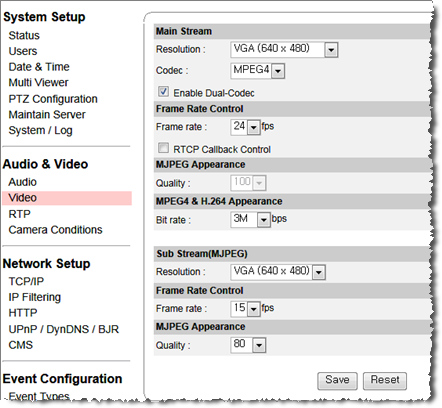
Login Data
The default setting is: Username admin and Password root.
Audio is supported upon activation:
The transport protocols TCP, UDP and multicast are supported. All three use the same URL.
For multicast, the check box Use Camera Settings must be activated and the multicast-specific settings must be specified via the Web interface of the camera. Specification of the multicast parameters via the Universal RTSP plugin is not allowed by CNB.
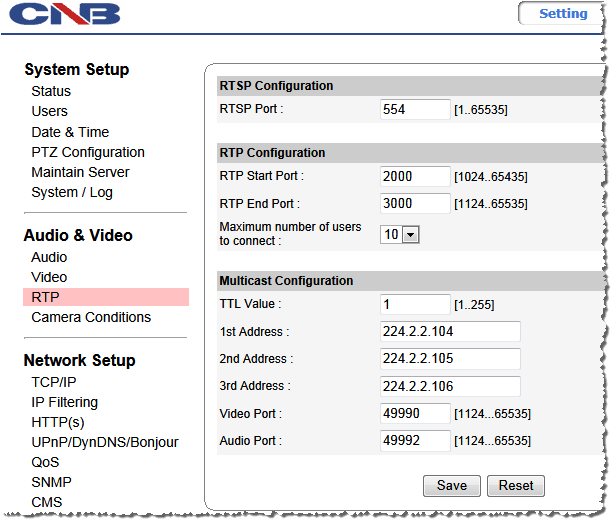
FLIR supports cameras with the Nexus web service. These include the F series cameras. Up until now, F-334 has been tested with firmware: Nexus Server v2.5.4.62
The Universal RTSP plugin supports the H.264 and MJPEG formats of this camera. There is no audio support.
The settings are made at the following location. Login as admin and then use Modules > Video.
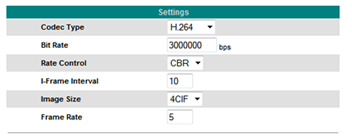
Note that the settings are not applied until the Save button below is pressed. In addition, the Nexus server must be restarted with Stop and Start. Refresh is not sufficient!

The RTSP-URL is the same for JPEG and H.264. The ending depends on the text entered under Stream Name. The default is ch0: rtsp://ip/ch0
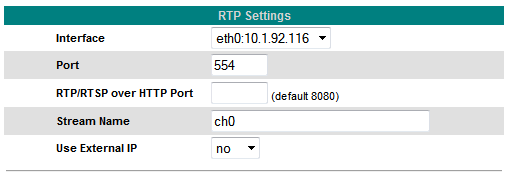
The transport protocols TCP, UDP and multicast are supported. All three use the same URL.
For multicast, the check box Use Camera Settings must be activated and the multicast-specific settings must be specified via the Web interface of the camera. Specification of the multicast parameters via the Universal RTSP plugin is not allowed by FLIR.
The preferred protocol is UDP. In addition, streaming over TCP and UDP is possible only when the setting Enable Multicast is set to No.
If multicast is to be used, multicast must be enabled as shown in the figure below. Then, transport is only possible via multicast and not over TCP or UDP.

Login Data
The default login details are: Username admin and Password indigo or Username: basic and Password: Nothing has to be entered here.
So far, the type DS2CD852MF-E and DS-2CD854F-E could be tested from HIKVISION. These cameras provides both H.264 and JPEG over RTSP. For this application, firmware V2.0 110131 or higher is required. Audio is as well supported and by default activated.
The camera has a main stream and a substream. These can be operated in dual stream mode, however the substream is only available at low resolutions (CIF resolution).
The quality settings are made in the following menu:
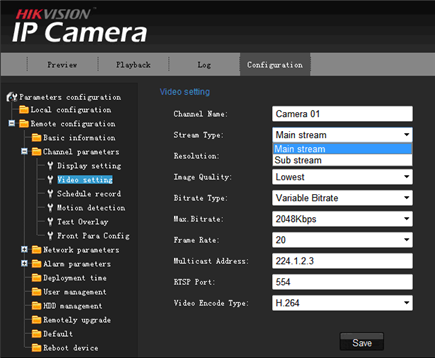
The RTSP-URL is always the same for JPEG and H.264:
-
For the main stream:
rtsp://ip/mpeg4/ch01/main/av_stream -
For the substream:
rtsp://ip/mpeg4/ch01/sub/av_stream
Login Data
The default setting is: Username: admin and Password 12345.
The transport protocols TCP, UDP and multicast are supported. All three use the same URL.
For multicast, the Use Camera Settings check box must be activated and the multicast-specific settings must be specified via the Web interface of the camera. Specification of the multicast parameters via the Universal RTSP plugin is not allowed by HIKVISION.
So far, the type HDB-T320 and HDB-M120 could be tested from Hitron. These cameras provides both H.264 and JPEG over RTSP.
The two cameras, however, have different RTSP-URLs and a different number of streams.
The camera HDB T320 has two streams: A H.264 stream and a JPEG stream.
-
For the H.264 stream:
rtsp://ip/1/stream1 -
For the Jpeg stream:
rtsp://ip/1/stream2
The quality of the streams can be set here:
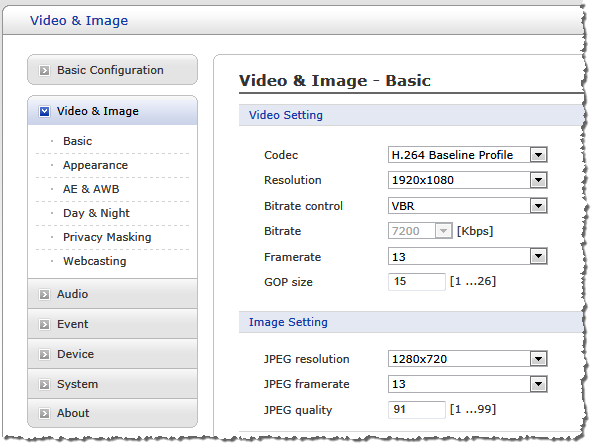
The camera HDB M120 has up to four streams. Three in H.264 and one in JPEG.
-
Stream 1 (H.264):
rtsp://ip/ch1/stream0 -
Stream 2 (Jpeg):
rtsp://ip/ch1/stream1 -
Stream 3 (H.264):
rtsp://ip/ch1/stream2 -
Stream 4 (H.264):
rtsp://ip/ch1/stream3
The quality of the streams can be set here:
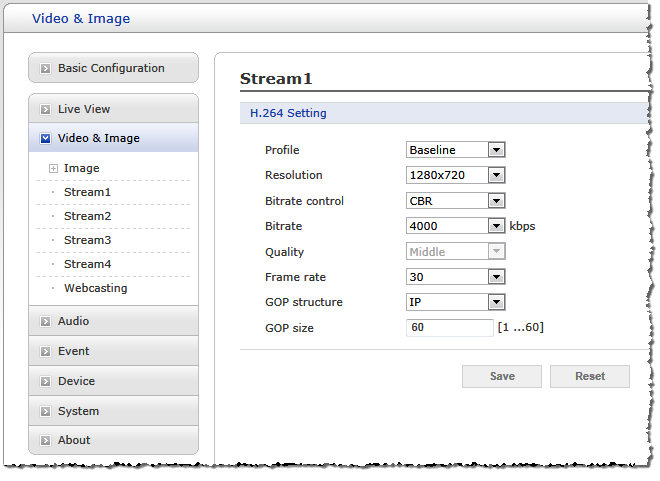
Audio functionality is available. Enable the codec G.711 for this purpose:
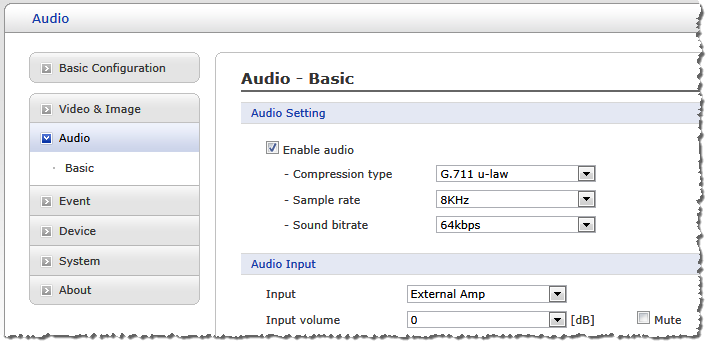
Login Data
The default setting is: Username admin and Password admin.
The transport protocols TCP, UDP and multicast are supported. All three use the same URL.
For multicast, the "Use Camera Settings" check box must be activated and the multicast-specific settings must be specified via the Web interface of the camera. Specification of the multicast parameters via the Universal RTSP plugin is not allowed by Hitron.
Some cameras do not support streaming over TCP in RTSP mode. This includes IQA22SI (Alliance). These cameras cannot be operated with the plugin.
With this plugin, only cameras that enable RTSP over TCP can be operated. This includes the IQ73xx, IQ83xx and IQD3xx models. Depending on the operating mode, these cameras can make dual streaming possible.
Example Here, for example, are setting options for an IQ832N: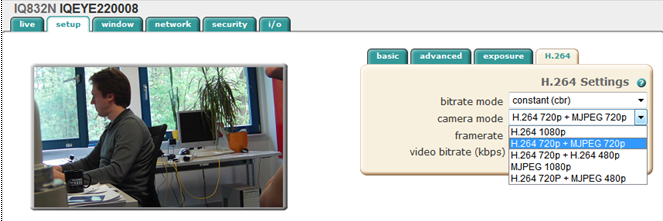
If the high-resolution stream is an H.264 stream, it is opened with rtsp://ip/rtsp/now.mp4.
If the second stream is also an H.264 stream (one at 720P the other at 480P), then the first stream is opened as specified above and the second stream is opened with rtsp://ip/rtsp/now.mp4?res=low.
If the second or even the main stream is an MJPEG stream, it is opened with rtsp://ip/now.jpg.
Login Data
The default setting is: Username root and Password system.
Some cameras also support audio. Once the audio function is activated, it is possible to use the audio data in G-Core.
The transport protocols TCP, UDP and multicast are supported. All three use the same URL.
For multicast, the Use Camera Settings check box must be activated and the multicast-specific settings must be specified via the web interface of the camera. Specification of the multicast parameters via the Universal RTSP plugin is not allowed by IQinVision.
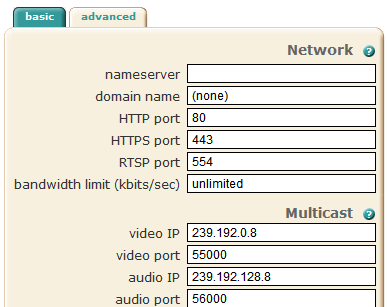
The camera series VN-Hxxx from JVC supports video streaming of H.264 and JPEG over RTSP. The cameras support up to three streams. The settings of the streams can be found here:
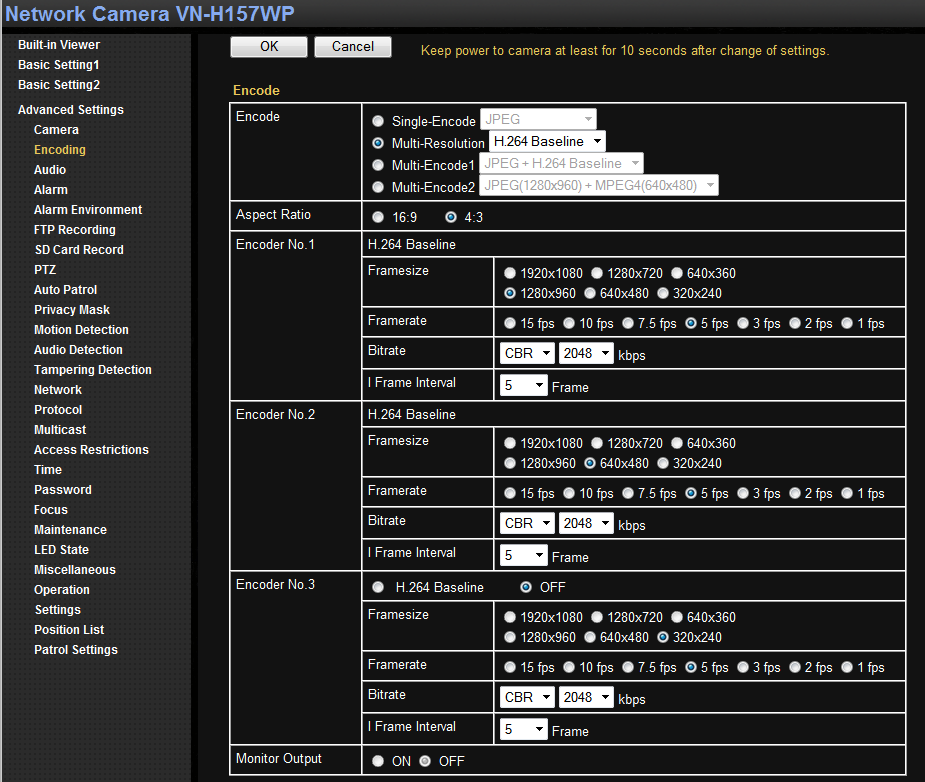
Encoders no. 1 - no. 3 are queried as follows:
-
Encoder No.1:
rtsp://ip/PSIA/Streaming/channels/1 -
Encoder No.2:
rtsp://ip/PSIA/Streaming/channels/2 -
Encoder No.3:
rtsp://ip/PSIA/Streaming/channels/3
Login Data
The default setting is: Username admin and Password jvc.
Only the transport protocol UDP is supported. TCP or multicast can also be set, however, the camera currently only sends UDP. Nevertheless, pictures can be seen.
Up until now, we have only tested the WV-SP306 camera. Other types of Panasonic may use other RTSP URLs.
The WV-SP306 camera is dual-stream capable. It can not provide MJPEG over RTSP. It is only possible to stream H.264 via the universal plugin. Also, streaming audio is not possible!
It is important to make the following settings:
-
Under Video encoding format, H.264 must be selected.
-
In addition, for the two streams H.264(1) and H.264(2), the options H.264 transmission and Internet mode (over http) must be enabled.
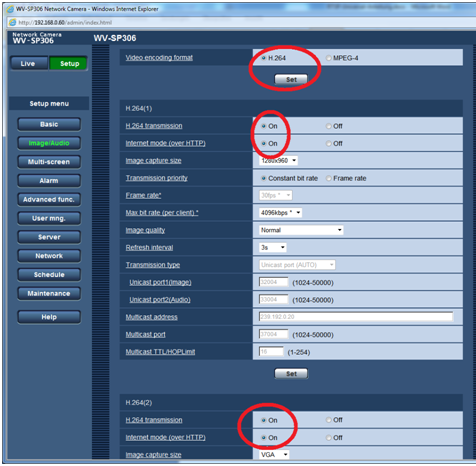
To open the first stream H.264(1) you must use the URL rtsp://ip/MediaInput/h264/stream_1.
To open the second stream H.264(2) you must use the URL rtsp://ip/MediaInput/h264/stream_2.
Login Data
The default login details are: Username admin and Password 12345.
Pelco Sarix cameras with FW: 1.8.2.1 could be successfully tested.
The settings of the stream can be specified here:
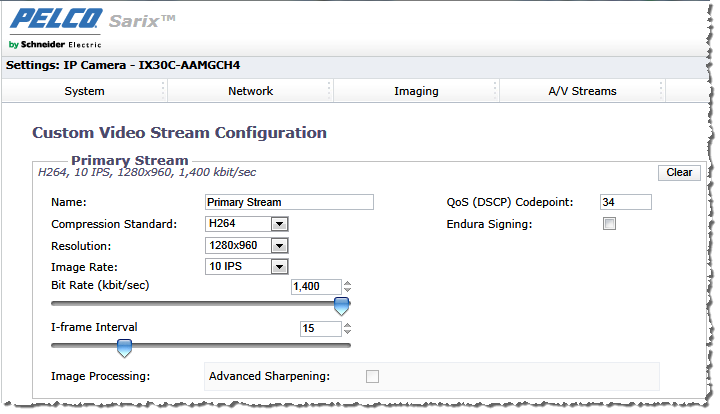
The following RTSP URL must be used: rtsp://ip/stream1
Login Data
The default login details are: Username admin and Password admin.
Only TCP and UDP are allowed as transport protocols. For all Pelco cameras, there is no support for multicast.
Samsung cameras have very different RTSP-URLs. Up till now, only the SNV-5080 camera could be tested. The camera is capable of dual streaming and can be accessed by multiple profiles.
To do so, you must setup the profiles using the Samsung interface.
-
Profile 1 is always JPEG.
-
Profile 2 is always H.264.
-
Profile 3 is not supported by the plugin. To make possible a second H.264 stream, for instance, this stream must be created using a new profile, for instance number 4.
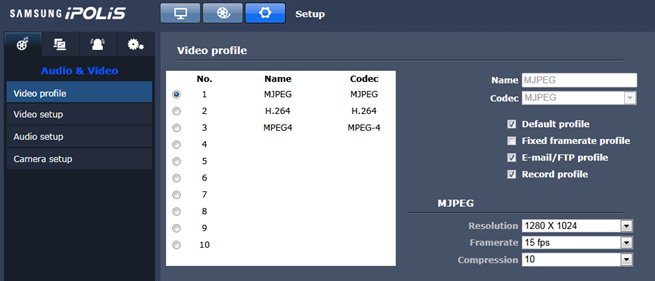
To ensure smooth operation in G-Core, it is absolutely necessary to disable the option Use Timeout in the camera. If this is not done, disconnections will occur continuously.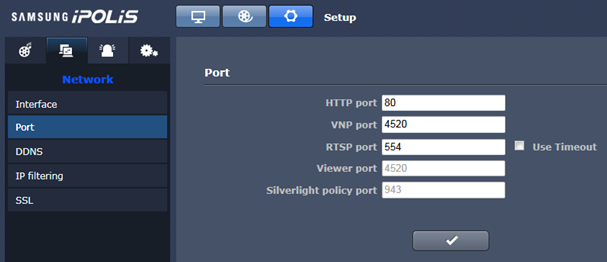
For Samsung cameras, there are different types of RTSP-URLs. The following are known:
-
For the types: SNB-5000, SND-5080, SNV-5080, SNV-3120, SNP-3120V the URL is
rtsp:// IP/profile<no>/media.smp, where<no>stands for the number of the profile.Example Here as an example is JPEG:
rtsp://ip/profile1/media.smp. -
For types: SNC-B2331/SNC-B5368/SNC-B2335/SNC-B5399/ NB-2000/SND-3080/SNB-3000/SNV-3080 the URL for JPEG is:
rtsp://IP/mjpeg/media.smpand for H.264:rtsp://IP/h264/media.smp.
Login Data
The login data are also dependent on the camera type. Refer to the following table:
For Samsung cameras, it may take a long time to switch to the camera, which is due to the performance of the camera. After the stream is opened, up to 3 seconds may pass before the first image arrives at G-Core.
Samsung cameras also support audio. The User Admin always has the right to stream audio. All other users must be assigned this right.The transport protocols TCP, UDP and multicast are supported. All three use the same URL.
For multicast, the Use Camera Settings check box must be activated and the multicast-specific settings must be specified via the Web interface of the camera. Specification of the multicast parameters via the Universal RTSP plugin is not allowed by Samsung.
For Sanyo there are three different camera types that are supported.
Login Data
All types have the same login information: admin for username and password.
VCC-HD4000
This type supports only H.264 over RTSP. JPEG over RTSP is not possible. In addition, this camera can only supply one stream. Therefore, dual-stream mode is not possible.
Firmware version 1.06 or higher must be installed. Specify the quality settings using the Sanyo interface.

The RTSP-URL is composed as follows: rtsp:// IP/ <ACCESS NAME>.
The ACCESS NAME is admin by default and can be changed in the interface, as shown above.
VCC-HD2100P, VCC-HD2300P, VDC-HD3100P and VDC-HD3300P
These cameras are so-called 1-chip models. They can provide JPEG and H.264 over RTSP.
In principle, it is possible with these cameras to stream both streams, one H.264 and one JPEG stream, at the same time, in practice however, the cameras have demonstrated that they are prone to crashing in this mode. Therefore, only use one stream. Dual stream is also not recommended unless you select a low resolution for both JPEG as well as H.264.
Specify the settings using the Sanyo interface. Make sure that under Protocol the option RTP over RTSP is selected.
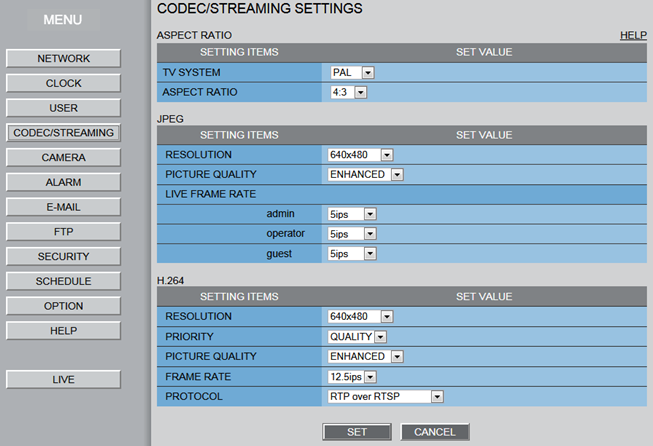
The RTSP-URL is composed as follows: rtsp://IP/<ACCESS NAME>.
The ACCESS NAME is set using the following interface under Network:
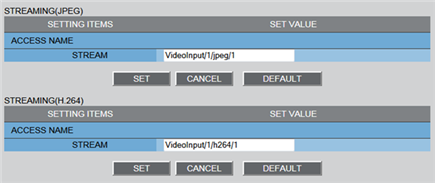
Thus, the following default values result:
-
For H.264:
rtsp://ip/VideoInput/1/h264/1 -
For JPEG:
rtsp://ip/VideoInput/1/jpeg/1
VCC-HD2500P, VDC-HD3500P, VCC-HD4600P, VCC-5400P and VCC-5600P
These cameras are so-called 2-chip models and have the highest performance. It is possible to parameterize up to four different streams. These streams, however, are all dependent on each other and cannot be parameterized freely.
With the plugin it is possible to stream JPEG as well as H.264. The cameras also operate very well in dual-stream mode. To do so, it is necessary to parameterize two streams as shown here. It is also possible to use two H.264 or JPEG streams.
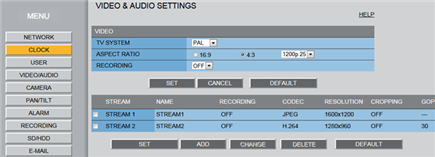
To select the correct RTSP-URL, first check again in the Network settings.
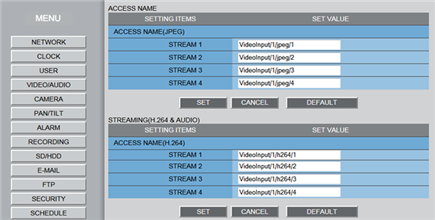
As you can see, there are different URLs for H.264 and for JPEG. Therefore, during setup you must decide whether stream 1 will be parameterized as JPEG or H.264.
You must then compose the URL as follows: rtsp://IP/<ACCESS NAME>
-
For stream 1 in JPEG, this is the resulting URL:
rtsp://ip/VideoInput/1/jpeg/1 -
For H.264 for stream 1, this is the resulting URL:
rtsp://ip/VideoInput/1/h264/1
The transport protocols TCP, UDP and multicast are supported. All three use the same URL.
For multicast, the Use Camera Settings check box must be activated and the multicast-specific settings must be specified via the Web interface of the camera. Specification of the multicast parameters via the Universal RTSP plugin is not allowed by Sanyo.
All cameras that have an audio input can also be recorded by G-Core. Audio must be activated in the cameras.
All 5th generation Sony IP cameras can be operated with the Universal RTSP plugin. The formats JPEG and H.264 incl. audio are supported. The cameras are dual-stream capable.
The settings for the video codec are configured in the menu Setup > Camera. The settings under Image 1 apply to the Main Stream, those under Image 2 to the Sub Stream.
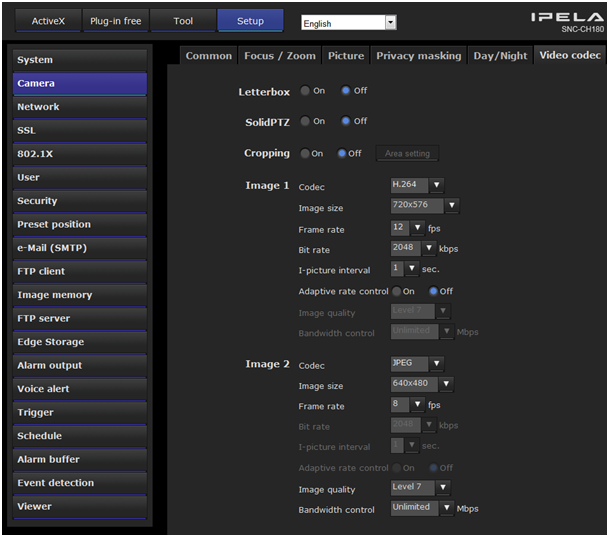
For audio settings, it is absolutely necessary to select the format G.711 or G.726. In addition, the Audio codec must be set to On .
Login Data
The default login details are: Username admin and Password admin.
To open the mainstream, use this RTSP URL: rtsp://ip/media/video1.
To open the substream, use this RTSP URL: rtsp://ip/media/video2.
The transport protocols TCP, UDP and multicast are supported. All three use the same URL. For multicast, the Use Camera Settings check box must be deactivated and the multicast-specific settings must be specified via the Universal RTSP plugin.
From the company Truen, the TCS-400 and TCAM-5320 devices were tested. Both devices deliver H.264 and JPEG over RTSP and are dual-stream capable. You can also transmit audio.
The settings for the video codec are made in the menu Setup > Video. The settings under Encode apply to the Main Stream, those under Dual Encode to the Sub Stream.
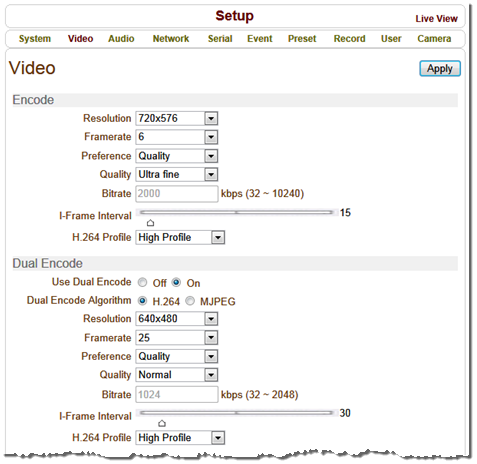
For audio settings, it is absolutely necessary to select the format G.711. In addition, the mode Tx-only or Tx & Rx must be selected so that the camera provides audio data.
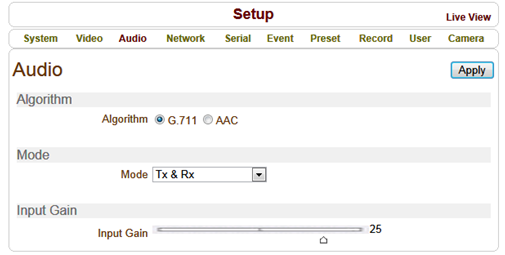
Login Data
The default login details are: Username admin and Password 1234.
To open the mainstream, use this RTSP URL: rtsp://ip/video1+audio1.
To open the substream, use this RTSP URL: rtsp://ip/video1s+audio1.
If the device is a multi-channel video server, you must specify the corresponding video channel.
It should be noted that the same audio input is always used.
Example
rtsp://ip/video1+audio1 for the first MainStreamrtsp://ip/video1s+audio1 for the first SubStreamrtsp://ip/video2+audio1 for the second MainStreamrtsp://ip/video2s+audio1 for the second SubStreamrtsp://ip/video3+audio1 for the third MainStreamrtsp://ip/video3s+audio1 for the third SubStreamrtsp://ip/video4+audio1 for the fourth MainStreamrtsp://ip/video4s+audio1 for the fourth SubStream
The transport protocols TCP, UDP and multicast are supported. All three use the same URL.
For multicast, the Use Camera Settings check box must be activated and the multicast-specific settings must be specified via the Web interface of the camera. Specification of the multicast parameters via the Universal RTSP plugin is not allowed by Truen.

The stream settings are made at the location shown:
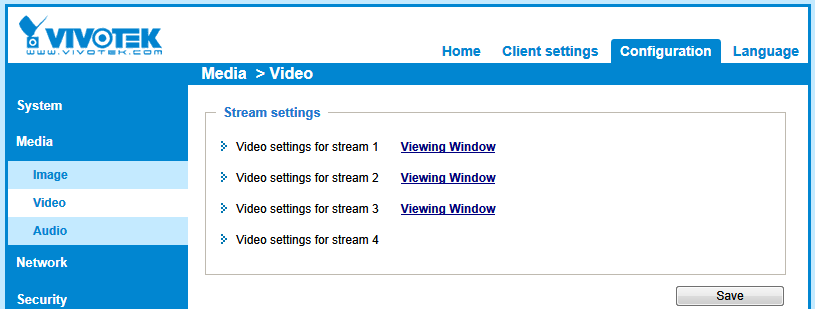
The camera is able to deliver up to four different streams. Thus, it is also possible to operate it as a dual-stream camera.
The transport protocols TCP, UDP and multicast are supported. All three use the same URL.
For multicast, the Use Camera Settings check box must be activated and the multicast-specific settings must be specified via the Web interface of the camera. Specification of the multicast parameters via the Universal RTSP plugin is not allowed by Vivotek.
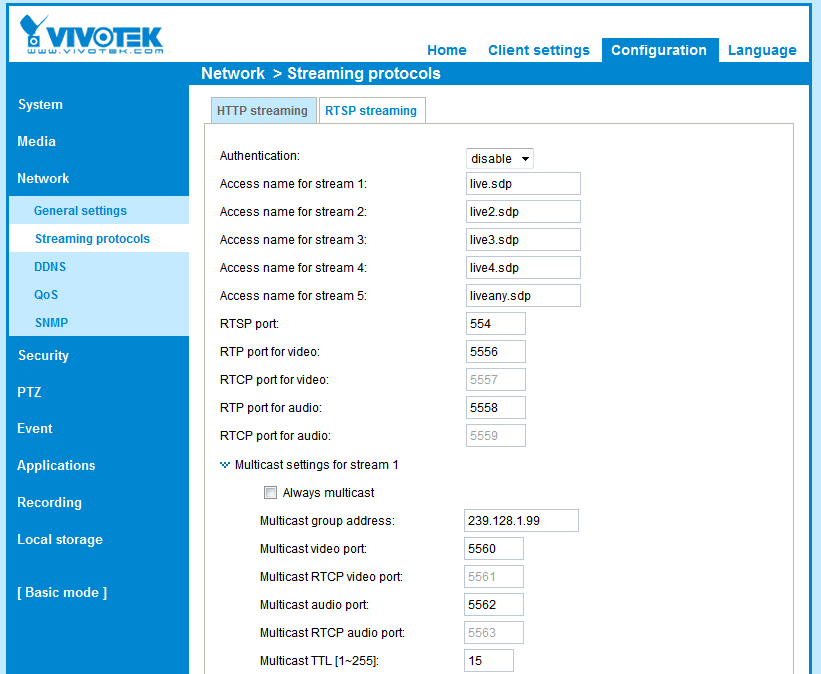
The following RTSP request must be used:
Example
For stream 1: rtsp://ip/live.sdp
For stream 2: rtsp://ip/live2.sdp
For stream 3: rtsp://ip/live3.sdp
For stream 4: rtsp://ip/live4.sdp
Login Data
By default, the cameras have no confirmation prompt. The main user is root with no password, which is the same as no user management.
Audio is also supported. It is only necessary to set the audio codec to G.711. The subcategories (pcmu or pcma) can be freely selected.
